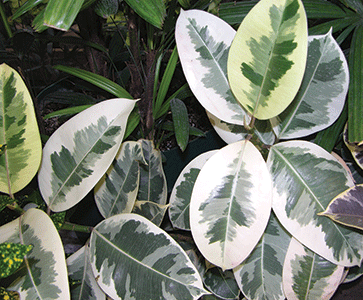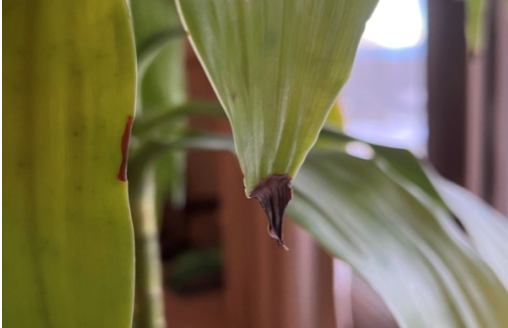Propagating houseplants is usually an easy procedure. Simply take cuttings, or slips, of new growth and place them in a rooting medium. In a few weeks they are rooted and ready to be potted. This procedure doesn’t work for all houseplants, as some are more successfully propagated using other techniques such as air layering and leaf cuttings. Iowa State University Extension and Outreach horticulturists offer tips to propagate favorite houseplants. For more information, contact the ISU Hortline at 515-294-3108 or [email protected].
How can I propagate a weeping fig?
The weeping fig (Ficus benjamina), rubber tree (Ficus elastica) and other woody Ficus species can be propagated by air layering. Air layering is a procedure used to induce roots to form on a plant stem while it is still attached to the parent plant. Complete or partial girdling of the plant stem interrupts the downward translocation of carbohydrates and other compounds. The accumulation of these compounds promotes rooting at the point of injury.
Materials needed to air layer houseplants include a sharp knife, sphagnum moss, a sheet of clear plastic, twist ties and a rooting hormone.
The procedure for air layering a weeping fig, rubber tree and other woody Ficus species is as follows:
Select a point on a stem about 12 to 18 inches from the shoot tip. Remove any leaves in the immediate area.
Using a sharp knife, make a cut completely around the stem. The cut should penetrate down to the woody center of the stem.
One inch below the first cut, make a second cut completely around the stem.
Finally, make a third cut connecting the previous two cuts. Remove the ring of bark. Scrape the exposed surface to insure complete removal of soft (cambial) tissue.
Dust a small amount of rooting hormone on the exposed surface. (The rooting hormone promotes root development.) Place one or two handfuls of moist sphagnum moss around the exposed area. Wrap a piece of clear plastic around the sphagnum moss. Make sure none of the moss protrudes out the ends of the plastic wrap. Secure the plastic wrap above and below the sphagnum moss with twist ties.
Roots should appear in the sphagnum moss in several weeks. When a good root system has developed, cut off the stem just below the bottom twist tie. Remove the twist ties and plastic sheet and plant the rooted stem in a container using a commercial potting mix.
How can I propagate a dieffenbachia or dumbcane?
The dieffenbachia (Dieffenbachia seguine), Chinese evergreen (Aglaonema commutatum) and corn plant (Dracaena fragrans) can be propagated by cane or stem cuttings. Cut a cane or stem into 2- to 3-inch-long sections. Each section should have at least two nodes. (The nodes are the thin, brownish rings that circle the stem.) Lay the sections horizontally on top of a rooting medium (perlite, coarse sand or vermiculite) and cover with additional material. The tops of the sections should be just below the surface of the rooting medium. Moisten the rooting medium. The cane sections should root and develop shoots in eight to 10 weeks. Pot up the new plants using a commercial potting mix.
How can I propagate an African violet?
African violets (Saintpaulia ionantha) are easily propagated by leaf cuttings. Select a firm, healthy leaf and cut it off with a sharp knife. Leave 1 to 1 1/2 inches of the leaf stem (petiole) attached to the leaf blade. Fill a pot with coarse sand, vermiculite or a 50:50 mix of perlite and sphagnum peat moss. Moisten the rooting medium. Insert the petiole of each leaf cutting into the rooting medium at a 45-degree angle. Firm the rooting medium around the petiole of each leaf cutting. After all cuttings are inserted, water the rooting medium and allow it to drain for a few minutes.
Next, cover the cuttings with a clear plastic bag. Secure the plastic bag to the pot with tape or a rubber band. (The enclosed environment drastically reduces the loss of water from the leaf cuttings and prevents them from wilting and dying before they have a chance to root.) Set the pot in a brightly lit location. Roots usually form in three to four weeks. The leaves of new plants usually appear in six to eight weeks. Several plants usually form at the base of each petiole. Separate the plants by carefully pulling or cutting them apart. Pot up plants individually into containers using a well-drained potting mix.
How can I propagate the snake plant or mother-in-law’s tongue?
The snake plant or mother-in-law’s tongue (Sansevieria trifasciata) can be propagated by leaf section cuttings. Remove a leaf and cut it into 3- to 4-inch-tall sections. For each section, the area closest to the base of the parent plant is the bottom and the farthest away is the top. Dip the bottom end of each section in a rooting hormone and then insert it one to two inches deep into a moistened rooting medium (perlite, coarse sand, or vermiculite). Keep the rooting medium moist with periodic watering. New shoots should appear in two months.
How can I propagate a Christmas cactus?
Thanksgiving, Christmas and Easter cacti can be propagated from stem segments. Remove a section of the plant consisting of two to five stem segments. Pinch or cut off the section at a joint. Leave the cuttings on a table or counter overnight to allow the cut ends to form callous tissue. Insert the cut /pinched end of each cutting about 1 inch deep in moistened perlite. Firm the perlite around each cutting to keep it upright. After all the cuttings have been inserted, water the perlite well and place the cuttings in bright, indirect light. Periodically water the perlite over the next several weeks to keep the rooting material moist. The cuttings should root in six to eight weeks. When the roots are 1 inch or longer, plant the cuttings in a small pot using a well-drained potting mix.


